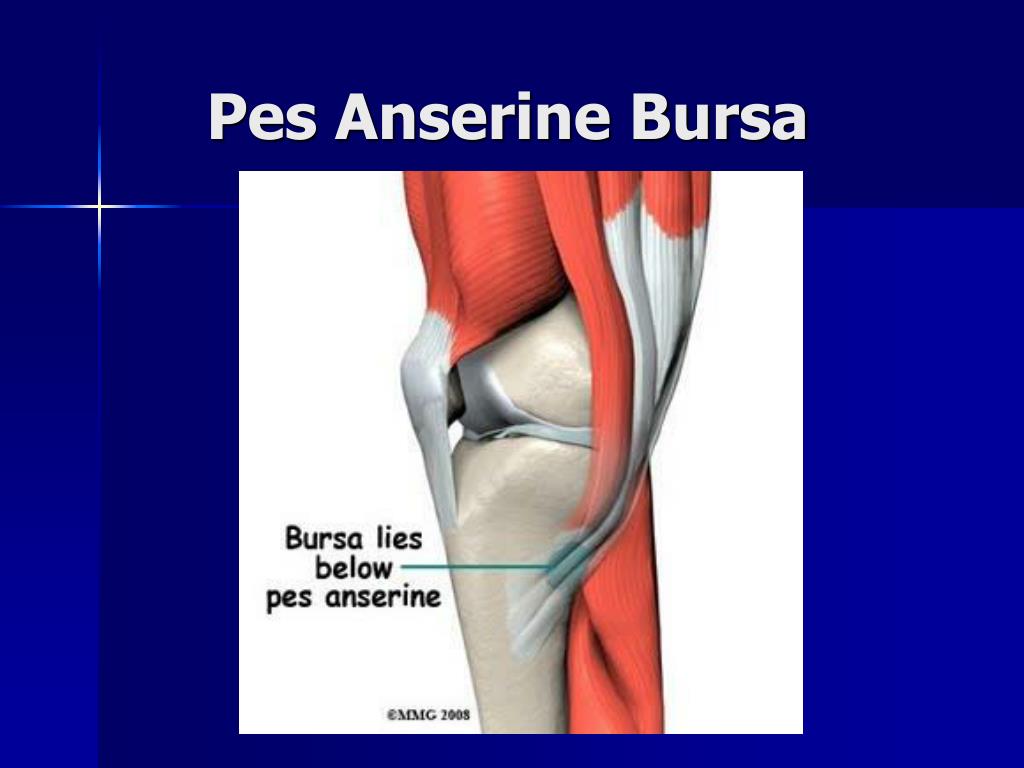
We see a lot of athletes, but they are not the only ones that do repetitive activities. Tendons of the Pes Anserine act on both the hip and knee, so repetitive motion and overuse of both the hip and knee can lead to excessive stress on the tendons. See alsoĬommon Causes of Pes Anserine Bursitis. increased fluid within the bursa thickened bursal wall surrounding tissue edema abnormal wall / surrounding tissue enhancement With the correct history of pain, many clinicians will diagnose pes anserinus bursitis based on the presence of increased bursal fluid alone. The actual signs are those of bursitis anywhere else in the body 1. The pes anserinus, consisting of the conjoined tendons of the sartorius, gracilis, and semitendinosus muscles and their insertions at the medial aspect of the knee, is often neglected during imaging assessment. Medial collateral ligament bursitis in a patient with knee osteoarthritis.

Corticosteroid injection is an effective and safe treatment modality for the management. MCL bursitis, which is a rare condition, must be considered for the differential diagnosis of increased medial knee pain in patients with knee OA.
PES BURSA SKIN
Use ethyl chloride spray to “numb” the skin over the injection site. 13,14 A few studies have shown that injection into the pes anserine bursa can be an effective treatment. 12 Pes anserine bursitis, also known as pes anserine tendino-bursitis (PATB) is a condition in which this entire area becomes inflamed. Fill a 27G 1/2″ tuberculin syringe with 0.5-ml of 1% lidocaine. A bursa exists underneath these tendons, and its location has been well-described in an anatomical study. Then inject about 0.5-ml to create the skin wheal. Pain increasing with exercise or climbing stairs Puffiness or tenderness to the touch in this area The symptoms of pes anserine bursitis include: Pain slowly developing on the inside of your knee and/or in the center of the shinbone, approximately 2 to 3 inches.

Other causes of bursitis in the foot can include: Wearing ill-fitting shoes or shoes not appropriate for a particular sport or activity level Repetitive running, jumping, or other. A simple rule to stick to: if it hurts don’t force it, Anserine Bursa Knee. Rest is probably the first thing you should try. Top Suggestions For Pes Anserine Bursitis Pain. Top Suggestions For Pes Anserine Bursitis Treatment. This can help take pressure off your knee joint.See also Hand Bursa Related Searches For Pes Bursitis

If you're working on your knees or participating in sports that put your knees at risk, use padding to cushion and protect your knees. To avoid knee bursitis or prevent its recurrence: Pes anserine bursitis, affecting the inner side of your knee below the joint, often occurs in obese women with osteoarthritis. Runners can develop pain and inflammation in the pes anserine bursa, situated on the inner side of your knee below the joint.

Sports that result in direct blows or frequent falls on the knee - such as wrestling, football and volleyball - can increase your risk of knee bursitis. People who work on their knees for long periods - carpet layers, plumbers and gardeners - are at increased risk of knee bursitis. Knee bursitis is a common complaint, but your risk of developing this painful disorder can increase from: Complications from osteoarthritis, rheumatoid arthritis or gout in your knee.Frequent and sustained pressure, such as from kneeling, especially on hard surfaces.Request an Appointment at Mayo Clinic Causes


 0 kommentar(er)
0 kommentar(er)
